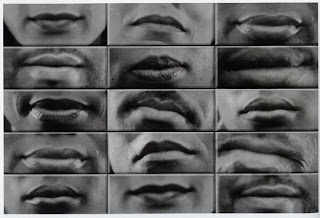
Monday, April 26, 2010
art & identity and art & the body
2. Humor was brought up to be the great universalizer, bringing everyone from every background to a common perspective. I've always found this device to be the most pleasant for addressing important points, and many agree with me - that's why Jon Stewart and Steve Colbert are so popular. Shows like Family Guy also emphasize really really wrong stereotypes but everyone (of liberal demeanor) loves it because they know they're just joking but making a good point. I dunno, everyone enjoys a laugh it is true, but there's also a thing called taste that divides us all again, once again another marker of personal identity, forged in our upbringing.
3. A big DUH!!! moment: Cinema assumed a male viewer -> so did all Western Art --> DUH!!! Big realization for the feminists!! "The female nude flatters men by reinforcing their dominance while relegating women to the role of fantasy objects." So the feminists eliminated the female figure and/or replaced the male gaze with a female one.
4. NEA critics said they supported the X Portfolio as evidence that it supported porn - who are these critics of the NEA? Artists who don't get the grants? Traditionalists? Churchies?
5. Did the feminists start everything that changed Modern Art? They apparently started Body Art and Performance, and Identity art too.....
Monday, April 19, 2010
For today: Art & Nature and Technology, Art & Deformation
1) Okay, this chapter was much different than what I anticipated. It started out with the artists I was expecting, including Andy Goldsworthy and such, but then it became not about nature but the politics surrounding how humans are screwing with nature. (I suppose I wasn't reading the title of the chapter correctly, forgetting the "and technology") But I suppose the discrepancy I experienced is sort of a point the author was trying to make - before art and nature was about making art with nature, and since Postmodernism it's now become using nature for art that has a political message.
2) There's Eco-Art and Bio-Art. I think both these categories are poor and can summarize my feelings thus: Eco-Art is really environmental activism and can't really be called Art, Bio-Art is mostly "artists" who were once nerdy kids creating their own science fiction. True, both the central issues these both address are important - man destroying nature and himself and the whole "Slippery Slope" with both of those - but somehow putting these serious issues under the term Art somehow makes it less serious to me, almost hypocritical.
Art & Deformation
3) Interesting: the increased rejection of the idealized body in art happened right alongside society's increasing demand for physical perfection in the media. The explanation for this is that artists have always made art that rejects the current trends of society. Always questioning we are...
4) Our fascination with portraying deformation is it's function: grotesque and abjections "subvert the idealized representation and bring us closer to the truth of being human." A basic process, compare and contrast two opposites to arrive and the definition of what's in the middle (a mathematical principle, the average.)
5) This chapter had more to do with Identity than the Art & Identity chapter - that one was mostly about Art & Stereotypes.
Sunday, April 4, 2010
Suck It
Suck It: a cynicist’s manifesto
· 1. Cynicism is our biggest virtue. We question everyone’s motives and we laugh at all forms of genuine belief or sincerity of expression. Political issues are always up for criticism, as are religion and the environmentalists.
· 2. Exploitation is key – we exploit the un-artucated*, for it is what allows our livelihood to function in the Art world. You have no idea what sawing a horse into sections and putting them in a glass case could possibly have to do with Art, but it DOES because we tell you it does, and you buy it. You buy it because we wear designer eyewear and dark clothing and therefore we know what we are talking about, and what’s best for you.
*Sub-point: we also make up words to further our purposes of making you believe anything we say about Art so that you will think it’s important and buy it.
· 3. Exploitation of other cultures has become a major tool. The aesthetic of the rich white aristocrat is no longer very… flavorful. It’s boring and passé. But the culture of others is much more spicy – literally, it smells like curry! So we’ll use their motifs and designs as our own to make it more worldly and exciting.
· 4. Acrylic is the best medium. After all, is it not true that Art represents the trends of its own contemporary society? And today’s society is all about mass-production and consumption of genetically altered and machine-made products, so why wouldn’t we make paintings that look like the neon glow of Times Square? Slather on that day-glow pink shiny resin, all over that canvas, until it’s thick like the Pepto Bismal signs on the subways!
· 5. Abstract is never passé. Who says Modernism is dead? We can still get away with painting indistinct lines on a black background and call it meaningful, just make it a little shinier.
· 6. Sculpture is still perfectly acceptable, but it has to make even less sense than a black and pink shiny painting. And it can’t be made in any historic media, like clay or bronze – it must be mostly found objects that most people see as trash before they take a closer look to discover its true meaning.
· 7. Going digital – the whole world is pretty much there already. No longer are we interested in what marks humans can make but what humans can make with machines and computers – after all, we made them to think better than we can. So use your machines to sculpt some blue bulbous animal-like aliens and place them in a stark white environment that exists nowhere and then have a huge printer recreate it in 1,000dpi for a nice wall piece. The White Cube could probably get $15,000 for it.
· 8. Making to sell is paramount, as always, but don’t think that there aren’t those who still prefer spiritual Art. Like we said, Modernism isn’t dead – acrylic coated candy wrappers smeared to some plywood will take you to a simpler childhood time. And no one gets tired of flowers, even though they might say so.




